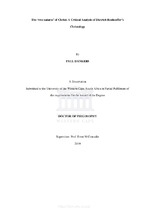| dc.description.abstract | This study will contribute to the substantial corpus of secondary scholarship on the life, ministry, and theology of the German theologian, church leader, and modern-day martyr Dietrich Bonhoeffer (1906-1945). Bonhoeffer’s legacy has also elicited considerable interest in the South African context, concerning a wide variety of themes such as the Confessing Church movement, secularisation, discipleship, confessing guilt, spirituality, and ethics. The critical question articulated by Bonhoeffer predominantly in his Letters and Papers from Prison, namely ‘Who is Jesus Christ, for us, today?’ has been raised by different generations of South African theologians in rapidly changing contexts. This study will concentrate on Bonhoeffer’s own Christology. The focus will be not so much on the significance of the life and ministry of Jesus Christ within a particular social context, but on how Bonhoeffer understands the person of Christ. More specifically, the problem investigated in this study is how Dietrich Bonhoeffer’s evolving views on the so-called ‘two natures’ of Christ should be understood. The Nicene confession,’ that Jesus Christ is Lord, that he is ‘truly God’ and ‘of one being with the Father, ’ prompted considerable reflection in Patristic Christianity. One crucial question was how the confession of the divinity of Christ reconciles with the humanity of Jesus of Nazareth portrayed so vividly in the canonical gospels. The formulation of the Council of Chalcedon, namely that one may speak of ‘two natures’ and ‘one person,’ has never been satisfactory and prompted further controversy but remains a point of reference in ongoing Christological debates to this day. The question, therefore, raised: How does Bonhoeffer understand the relationship between the ‘divine’ and the ‘human’ nature of Jesus Christ? This question is pertinent given the consistent Christological concentration in Bonhoeffer’s theology (even to the point of a Trinitarian reductionism), his increasing emphasis on a ‘this-worldly’ understanding of God’s transcendence and his consistent Lutheran intuition that the finite can indeed contain the infinite.
Bonhoeffer’s Christology has been the subject of much scholarly interest. There is consensus that his Christology remains not only incomplete but also unresolved. A core problem in this regard is his understanding of the divine nature of Christ – which he assumes but of which he does not offer any full account. This study will contribute to the available literature by exploring Bonhoeffer’s understanding of the ‘two natures’ of Christ based on the primary and secondary research with specific reference to Sanctorum Communio (1927/1963), Act and Being (1930/1996), Christology, Discipleship (1937/1959), Ethics (1955, 6th edition and 2005, new critical edition) and Letters and Papers from Prison (2010).
There has been considerable controversy in Bonhoeffer scholarship regarding the continuity and discontinuity in Bonhoeffer’s theological thinking from his student years to his death in 1945. It would, therefore, be wise to allow for Bonhoeffer’s ‘evolving’ views on the ‘two natures’ of Jesus Christ to speak for itself. This study will seek to describe and assess (in terms of Bonhoeffer’s sources and secondary scholarship) Bonhoeffer’s views in each of his main works to trace the developments in his thinking. | en_US |

